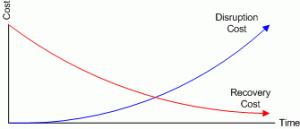Business Continuity
For any business owner, three objectives exist when planning to prevent or recover from a disaster:
- The assurance of never losing critical information
- Reducing downtime when emergencies happen
- Quick recovery after a loss of data.
These three objectives translate into three IT services:
- Backups: The process of protecting your data by copying it to a secure device so that it can be easily and and quickly recovered in case of loss.
- Disaster Recovery: The process of reinstating crucial business data and procedures after a disaster happens.
- Business Continuity: A carefully constructed plan that specifies exactly how your company will recover and re-establish disrupted functions after disaster strikes.
Backups are an essential part of your IT strategy, even if you just have a single computer at your home office. Changes in technology have opened up new options for backup. Cloud computing offers large amounts of storage at low cost. Improvements in broadband service make it more practical to consider backing up over your internet connection. Imaging tools combined with Virtual Machine technology make it feasible for small business to recover from a lost server in hours instead of days.
However, the fundamentals of disaster prevention have not changed. A backup and disaster prevention strategy is still created by thinking through these issues:
- Identify the data that is critical to your business, and where it is stored. Be aware of where your email is stored. Identify programs that use some form of database that runs on a server, which may have special backup requirements. Identify offsite data that may need protection as well, such as your website.
- Identify dependencies – Determine which services, such as internet access, are required for your business to function.
- Identify information that may be required to restore services – vendor contacts, software media and license keys, passwords etc.
- Consider the types of things that could go wrong, how likely they are, and the consequences.
- Determine how long you can be without specific types of data or functionality if these things did go wrong, and what the cost would be, including the cost of loss or temporary unavailability. This determines your “service level”.

- Create a backup and disaster prevention plan which allows you to recover functionality within the requirements of your service level. Create accountability by determining who is responsible.
- Develop a plan to monitor and regularly test your business continuity strategy.
Security and disaster prevention are closely related. Preventing Viruses and Hackers has become a critical part of staying in business.
We can consult with you to help develop a good plan of action, and then implement and monitor it. We offer solutions for local and offsite backup.


